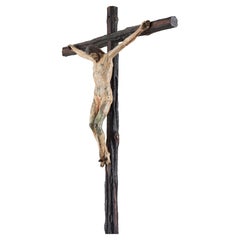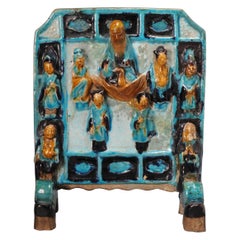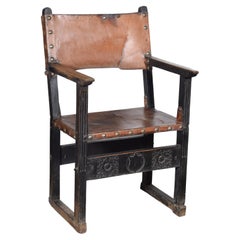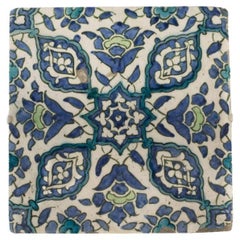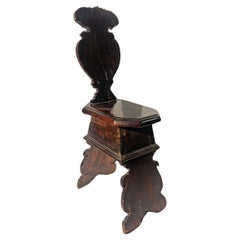16th Century Furniture
14
1,088
to
94
685
359
1,088
1,088
1,088
35
25
16
7
5
3
2
2
1
1
1
1
39,136
131,680
521,673
275,406
83,095
256,301
120,515
12,550
5,856
18,316
22,881
19,528
54,156
72,441
60,018
21,581
8,794
384
217
169
145
142
627
253
181
151
114
12
6
4
4
3
Period: 16th Century
Rare and important painted bronze Crucifix after a model by Michelangelo
By Michelangelo Buonarroti
Located in Leesburg, VA
A rare and very fine bronze corpus of Christ after a model by Michelangelo, cast ca. 1597-1600 by Juan Bautista Franconio and painted in 1600 by Francisco Pacheco in Seville, Spain.
The present corpus reproduces a model attributed to Michelangelo. The best known example, lesser in quality, is one on display at the Metropolitan Museum of Art (MET).
The association of this corpus with Michelangelo was first brought to light by Manuel Gomez-Moreno (1930-33) who studied the wider circulated casts identified throughout Spain. The attribution to Michelangelo was subsequently followed by John Goldsmith-Phillips (1937) of the MET and again by Michelangelo expert, Charles de Tolnay (1960).
While Michelangelo is best known for his monumental works, there are four documented crucifixes he made. The best known example is the large-scale wooden crucifix for the Church of Santa Maria del Santo Spirito in Florence, made in 1492 as a gift for the Prior, Giovanni di Lap Bicchiellini, for allowing him to study the anatomy of corpses at the hospital there. In 1562, Michelangelo wrote two letters to his nephew, Lionardo, indicating his intention to carve a wooden crucifix for him. In 1563 a letter between Lionardo and the Italian sculptor Tiberio Calcagni, mentions this same crucifix (a sketch of a corpus on the verso of a sheet depicting Michelangelo’s designs for St. Peter’s Basillica [Palais des Beaux-Arts in Lille] may reproduce this). That Michelangelo was working on small corpora in the last years of his life is further evidenced by the small (26.5 cm) unfinished wooden crucifix located at the Casa Buonarroti, considered his last known sculptural undertaking. Michelangelo’s contemporary biographer, Giorgio Vasari additionally cites that Michelangelo, in his later years, made a small crucifix for his friend, Menighella, as a gift.
Surviving sketches also indicate Michelangelo’s study of this subject throughout his career, most notably during the end of his life but also during the 1530s-40s as he deepened his spiritual roots. The occasional cameo of crucified Christ’s throughout his sketched oeuvre have made it challenging for scholars to link such sketches to any documented commissions of importance. All the while, in consideration that such objects were made as gifts, it is unlikely they should be linked with commissions.
Nonetheless, a number of theories concerning Michelangelo’s sketches of Christ crucified have been proposed and some may regard the origin of the present sculpture. It has been suggested that the corpus could have its impetus with Michelangelo’s work on the Medici Chapel, whose exclusive design was given to the master. It is sensible smaller details, like an altar cross, could have fallen under his responsibility (see for example British Museum, Inv. 1859,0625.552). Others have noted the possibility of an unrealized large marble Crucifixion group which never came to fruition but whose marble blocks had been measured according to a sheet at the Casa Buonarroti.
A unique suggestion is that Michelangelo could have made the crucifix for Vittoria Colonna, of whom he was exceedingly fond and with whom he exchanged gifts along with mutual spiritual proclivities. In particular, Vittoria had an interest in the life of St. Bridget, whose vision of Christ closely resembles our sculpture, most notably with Christ’s proper-left leg and foot crossed over his right, an iconography that is incredibly scarce for crucifixes. The suggestion could add sense to Benedetto Varchi’s comment that Michelangelo made a sculpted “nude Christ…he gave to the most divine Marchesa of Pescara (Vittoria Colonna).”
Of that same period, two sketches can be visually linked to our sculpture. Tolnay relates it to a sketch of a Crucified Christ at the Teylers Museum (Inv. A034) of which Paul Joannides comments on its quality as suggestive of preparations for a sculptural work. Joannides also calls attention to a related drawing attributed to Raffaello da Montelupo copying what is believed to be a lost sketch by Michelangelo. Its relationship with our sculpture is apparent. Montelupo, a pupil of Michelangelo’s, returned to Rome to serve him in 1541, assisting with the continued work on the tomb of Pope Julius II, suggesting again an origin for the corpus ca. 1540.
The earliest firm date that can be given to the present corpus is 1574 where it appears as a rather crudely conceived Crucifixion panel, flanked by two mourners in low-relief and integrally cast for use as the bronze tabernacle door to a ciborium now located at the Church of San Lorenzo in Padula. Etched in wax residue on the back of the door is the date, 27 January 1574, indicating the corpus would have at least been available as a model by late 1573.
The Padula tabernacle was completed by Michelangelo’s assistant, Jacopo del Duca and likely has its origins with Michelangelo’s uncompleted tabernacle for the Basilica of St. Mary of the Angels in Rome.
The impetus for the Padula tabernacle’s Crucifixion panel begins with a series of late Crucifixion sketches by Michelangelo, depicting a scene of Christ crucified and flanked by two mourners (see British Museum Inv. 1895.0915.510; Ashmolean Museum Inv. 1846.89, KP II 343 recto; Windsor Castle RCIN 912761 recto; and Louvre Inv. 700). A faintly traced block possibly intended for sculpting the sketch of the crucified Christ on its recto was discovered by Tolnay on a version of the composition at Windsor Castle. The Windsor sketch and those related to it appear to have served as preparatory designs for what was probably intended to become the Basilica of St. Mary’s tabernacle door. Vasari documents that the project was to be designed by Michelangelo and cast by his assistant, Jacopo del Duca. Michelangelo died before the commission was complete, though on 15 March 1565, Jacopo writes to Michelangelo’s nephew stating, “I have started making the bronze tabernacle, depending on the model of his that was in Rome, already almost half complete.” Various circumstances interrupted the completion of the tabernacle, though its concept is later revitalized by Jacopo during preparations to sell a tabernacle, after Michelangelo’s designs, to Spain for Madrid’s El Escorial almost a decade later. The El Escorial tabernacle likewise encountered problems and was aborted but Jacopo successfully sold it shortly thereafter to the Carthusians of Padula.
An etched date, 30 May 1572, along the base of the Padula tabernacle indicates its framework was already cast by then. A 1573 summary of the tabernacle also describes the original format for the door and relief panels, intended to be square in dimension. However, a last minute decision to heighten them was abruptly made during Jacopo’s negotiations to sell the tabernacle to King Phillip II of Spain. Shortly thereafter the commission was aborted. Philippe Malgouyres notes that the Padula tabernacle’s final state is a mixed product of the original design intended for Spain’s El Escorial, recycling various parts that had already been cast and adding new quickly finished elements for its sale to Padula, explaining its unusually discordant quality, particularly as concerns the crudeness of the door and relief panels which were clearly made later (by January 1574).
Apart from his own admission in letters to Spain, it is apparent, however, that Jacopo relied upon his deceased master’s designs while hastily realizing the Padula panels. If Michelangelo had already earlier conceived a crucifix model, and Jacopo had access to that model, its logical he could have hastily employed it for incorporation on the door panel to the tabernacle. It is worth noting some modifications he made to the model, extending Christ’s arms further up in order to fit them into the scale of the panel and further lowering his chin to his chest in order to instill physiognomic congruence. A crude panel of the Deposition also follows after Michelangelo’s late sketches and is likewise known by examples thought to be modifications by Jacopo based upon Michelangelo’s initial sculptural conception (see Malgouyres: La Deposition du Christ de Jacopo del Duca, chef-d’oeuvre posthume de Michel-Ange).
Jacopo’s appropriation of an original model by Michelangelo for more than one relief on the Padula tabernacle adds further indication that the crucifix was not an object unique to Jacopo’s hand, as few scholars have posited, but rather belongs to Michelangelo’s original...
Category
Renaissance Antique 16th Century Furniture
Materials
Bronze
Ming Period Fahua Pottery Chinese Table Screen Scholar Eight immortals Shoulou
Located in Amsterdam, Noord Holland
A chinese porcelain table screen from the Ming period, 16/17th century. Decorated in High Relief With Shoulou on his crane and the Eight Immorta...
Category
Chinese Antique 16th Century Furniture
Materials
Porcelain
Armchair, "frailero" or friar. Wood, leather. Spain, 16th century.
Located in Madrid, ES
Friar armchair. Walnut wood, leather. Spain, 16th century.
Armchair with arms and high back of the type known as “frailero”, which has leather with studs on the seat and upper part ...
Category
Spanish Renaissance Antique 16th Century Furniture
Materials
Other
An Ottoman Empire Damascus square tile late 16th century
Located in Lymington, Hampshire
An Ottoman Empire Damascus square tile, late 16th century, the glazed fritware body painted in underglaze green, blue, turquoise and black with four lobed medallions and four split p...
Category
Syrian Antique 16th Century Furniture
Materials
Ceramic
Antique Blue and White 'River Landscape' Bowl Foliate Rim Cranes, ca 1600
Located in Amsterdam, Noord Holland
The large bowl with foliated rim from around 1600, Ming period. The bowl is decorated with a continuous river landscape scene with pagodas, pavilions, boats and cranes in a pine tree. The interior rim and interior central roundel are similarly decorated.
Additional information:
Material: Porcelain & Pottery
Region of Origin: China
Emperor: Ming Jiajing...
Category
Chinese Antique 16th Century Furniture
Materials
Porcelain
16th CENTURY GUARD'S STOOL
Located in Firenze, FI
Typical stool with backrest and curved legs in solid walnut wood with dark patina. This type of bench is used in guard posts, for this reason the seat is small and uncomfortable, to ...
Category
Italian Renaissance Antique 16th Century Furniture
Materials
Wood, Walnut
Rare Renaissance Florentine Cabinet with Certosina Decoration
Located in Saint-Ouen, FR
RARE RENAISSANCE FLORENTINE WALNUT CABINET WITH CERTOSINA DECORATION
ORIGIN: FLORENCE, ITALY
PERIOD: END OF 15th CENTURY – BEGINNING OF 16th CENTURY
Height: 129 cm
Length: 107 cm...
Category
Antique 16th Century Furniture
Materials
Walnut
A panel of four square Ottoman Empire ‘Dome of the Rock’ tiles
Located in Lymington, Hampshire
A panel of four square Ottoman Empire ‘Dome of the Rock’ tiles, painted in underglaze cobalt blue with a trellis of split and winged palmettes with cloud-scroll collars, framed. Syrian, 16th century.
15 in square, framed 17 ½ in square.
Provenance: Property of a private European collector.
Footnote: This design was first seen on the Dome of the Rock in Jerusalem, which was tiled on the instructions of the Ottoman Sultan Suleiman the Magnificent around 1545. Soon after similar tiles appeared on several building in Aleppo, most notably Bait Jumbiatt, the Ummayad Mosque and the Khosrowiyya Mosque, as well as numerous private houses. There are also near identical tiles in the Ramanazoglu Mosque in Adana (Turkey). See Arthur Miler ‘Damascus Tiles...
Category
Syrian Antique 16th Century Furniture
Materials
Ceramic
Rare Renaissance Caquetoire from the Fontainebleau School
Located in Saint-Ouen, FR
RARE RENAISSANCE CAQUETOIRES FROM THE FONTAINEBLEAU SCHOOL WITH A PERSPECTIVE MOTIF THAT COULD FORM A PAIR
ORIGIN : FRANCE, VAL DE LOIRE or ILE DE FRANCE
PERIOD : 16th CENTURY
Heig...
Category
Antique 16th Century Furniture
Materials
Walnut
Saint Paul, Carved and Polychromed Wood. Spanish School, 16th Century
Located in Madrid, ES
Spanish school of the sixteenth century. "Saint Paul". Carved and polychrome wood.
Devotional image of a round piece carved in wood, polychrome and gilded, representing the Apostle ...
Category
Spanish Renaissance Antique 16th Century Furniture
Materials
Other
Chinese Jade Figure of Guanyin
Located in Bradenton, FL
Most likely Ming 15th/16th Century, carved chicken bone jade figure of a standing Guanyin (Quanyin) holding a scroll in one hand, prayer beads in the other. Affixed to carved wood ba...
Category
Chinese Ming Antique 16th Century Furniture
Materials
Organic Material
Important Polychrome Low-Relief Depicting Christ in the Mount of Olives
Located in Saint-Ouen, FR
IMPORTANT POLYCHROME LOW-RELIEF DEPICTING CHRIST IN THE MOUNT OF OLIVES
ORIGIN: SOUTH GERMANY or ALSACE
PERIOD: ca. 1500-1510
Height : 78 cm
Length : 57 cm
Depth : 8 cm
Limewood
...
Category
Antique 16th Century Furniture
Materials
Wood
16th Century Rare Antique Brazer in Copper with Wrought Iron Pedestal
Located in Casale Monferrato, IT
This brazier from the 16th century Renaissance era is truly rare. The fire pit features a copper vessel and a beautifully crafted hand-forged iron pedestal. The pedestal has three fe...
Category
Italian Renaissance Antique 16th Century Furniture
Materials
Wrought Iron, Copper
Mid-16th Century Brussels Tapestry Pillow
Located in Los Angeles, US
Mid-16th Century Brussels Tapestry Pillow
Category
Belgian Empire Antique 16th Century Furniture
Materials
Wool
Framed 16th Century Italian Ivory Figure of Christ
By Interi
Located in Dublin, Dalkey
16th century Italian ivory figure of Christ mounted against green felt fabric and framed in a coordinating cream frame.
This piece was once originally pa...
Category
Italian Renaissance Antique 16th Century Furniture
Materials
Wood, Ivory, Felt
A panel of two square Ottoman Empire ‘Dome of the Rock’ tiles
Located in Lymington, Hampshire
A panel of two square Ottoman Empire ‘Dome of the Rock’ tiles, painted in underglaze cobalt blue, black and apple green with a trellis of split and winged palmettes with cloud-scroll...
Category
Syrian Antique 16th Century Furniture
Materials
Ceramic
Walnut Shutter Table
Located in Saint-Ouen, FR
WALNUT SHUTTER TABLE
ORIGIN: VAL-DE-LOIRE, FRANCE
PERIOD: HENRI II PERIOD, CIRCA 1550
Height: 74 cm
Width: 74 cm
Diameter: 92 cm
Walnut wood
Made of a beautiful walnut, this ro...
Category
Antique 16th Century Furniture
Materials
Walnut
Important Italian Renaissance Gardener
Located in Saint-Ouen, FR
IMPORTANT ITALIAN RENAISSANCE GARDENER
ORIGIN: NORTHERN ITALY
PERIOD: 16th CENTURY
Height: 52 cm
Length: 130 cm
Depth: 53 cm
Verona marble
Taking the form of an antique sarcopha...
Category
Antique 16th Century Furniture
Materials
Marble
Rare Renaissance Cabinet with Feather quill and Fenestration Decoration
Located in Saint-Ouen, FR
RARE RENAISSANCE CABINET WITH FEATHER QUILL AND FENESTRATION DECORATION
ORIGIN: FRANCE
PERIOD: EARLY 16th CENTURY
DIMENSIONS :
Height : 178 cm
Length : 145 cm
Depth : 58 cm
Walnu...
Category
Antique 16th Century Furniture
Materials
Walnut
Rare Chinese Porcelain Ming Period Kosometsuke Incense Burner, ca 1600
Located in Amsterdam, Noord Holland
It's 17th century chinese porcelain, Ming period, made for the Japanese market. This unusual Kosumetsuke Koro would have been used for incense that is added to the charcoal fire dur...
Category
Chinese Antique 16th Century Furniture
Materials
Porcelain
16th Century Carved Red Sandstone Roundel
Located in Wormelow, Herefordshire
An English medieval style carved red sandstone roundel possibly dating from as early as the 16th century. Likely once used as decoration for an exterior capital, this 400 – 500 year ...
Category
Medieval Antique 16th Century Furniture
Materials
Sandstone
Polidoro Caldara, called Polidoro da Caravaggio (Caravaggio 1499-1543 Messina)
Located in Nottingham, GB
16th century Italian old master pen, ink & wash drawing depicting an ancient roman scene - soldiers presenting prisoners brought before the Emperor for execution, watermarked, held in a neoclassical gilt frame under protective glass.
Polidoro Caldara, usually known as Polidoro da Caravaggio (c. 1499 – 1543) was an Italian painter of the Mannerist period, "arguably the most gifted and certainly the least conventional of Raphael's pupils", who was best known for his now-vanished paintings on the facades of Roman houses. He was unrelated to the later painter Michelangelo Merisi...
Category
Antique 16th Century Furniture
Materials
Paper
Thai Bronze Buddha Torso Fragment, Sukhothai, 15th/16th Century, Thailand
Located in Austin, TX
An enigmatic and ephemeral Thai cast bronze fragment of a seated Buddha, Sukhothai Kingdom, circa 15th/16th century, Thailand.
The fragment depicts the historical Buddha, Shakyamuni...
Category
Thai Antique 16th Century Furniture
Materials
Bronze
Antique Chinese Hongzhi or Zhengde Dish Fish, 15th/16th Century
Located in Amsterdam, Noord Holland
A very nicely decorated and highly unusual dish from the 15th/16th century. The dish is beautifully designed with a beautiful fish in the centre.
9-1-23-1-1
Additional information:...
Category
Chinese Ming Antique 16th Century Furniture
Materials
Porcelain
Rare Renaissance Table with Fixed Top
Located in Saint-Ouen, FR
RARE RENAISSANCE TABLE WITH FIXED TOP
ORIGIN: FRANCE
PERIOD : SECOND HALF OF THE 16th CENTURY, c. 1560-1580
Height: 87 cm
Length: 158 cm
Width: 78 cm
Walnut wood
Good condition...
Category
Antique 16th Century Furniture
Materials
Walnut
Antonio Allegri, Our Lady with the Child Jesus 16th Century
By Antonio da Correggio
Located in Madrid, ES
Antonio Alegri, (Correggio - 1494-1534)
Our Lady with the Child Jesus
oil on copper,
Italian School 16th century
With inscription on the back '1494-1534 Antonio Alegri, (Corregio) Lo...
Category
Italian Baroque Antique 16th Century Furniture
Materials
Copper
French Bronze Sculpture of Youth Wrangling a Horse by Guillaume Coustou
By Coustou
Located in Middleburg, VA
French Bronze Sculpture of Youth Wrangling a Horse by Guillaume Coustou (1677-1746). Best known for his monumental statues of horses, Coustou was the royal sculptor for Louis XIV an...
Category
French Louis XIV Antique 16th Century Furniture
Materials
Bronze
Vase de fouille (Niger, Afrique)
Located in PARIS, FR
Peut-être 15e-17e s. objet de fouille du Niger (Afrique), belle engobe en argile rouge avec bandes incisées, col haut se terminant par une lèvre évasée, bel exemplaire.
Bel objet décoratif...
Category
Nigerien Tribal Antique 16th Century Furniture
Materials
Terracotta
Florentine Credenza with Corner Columns
Located in Saint-Ouen, FR
FLORENTINE CREDENZA WITH CORNER COLUMNS
ORIGIN : TOSCANY, ITALY
PERIOD : LATE 16th CENTURY
Height: 84 cm
Width: 101 cm
Depth: 48 cm
Walnut wood
Although the first Italian cre...
Category
Antique 16th Century Furniture
Materials
Walnut
Renaissance Cathedra with Perspective Motif
Located in Saint-Ouen, FR
RENAISSANCE CHAYÈRE WITH PERSPECTIVE MOTIF
ORIGIN: FRANCE, LYON
ÉPOQUE: FIRST HALF OF THE XVI CENTURY
Height: 166cm
Width: 74cm
Depth: 47cm
Walnut wood
From: Château de Quintin’...
Category
Antique 16th Century Furniture
Materials
Walnut
Saint Catherine of Alexandria
Located in Saint-Ouen, FR
SAINT CATHERINE OF ALEXANDRIA
ORIGIN : SWABIA, ULM REGION
PERIOD : ca. 1510-1520
Height : 118 cm
Length : 39 cm
Depth : 17 cm
Limewood...
Category
Antique 16th Century Furniture
Materials
Wood
16th Century French Renaissance Chest in Carved Oak
Located in Dallas, TX
Whereas many pieces of furniture during the Italian Renaissance were heavily painted or inlaid with decorative motifs, French examples utilized hand-sculpted elements as the predomin...
Category
French Renaissance Antique 16th Century Furniture
Materials
Wood, Oak
Important Sculpture Representing Saint Barbara
Located in Saint-Ouen, FR
IMPORTANT WOOD SCULPTURE REPRESENTING SAINT BARBARA
ORIGIN : NORTHERN FRANCE OR FLANDERS
PERIOD : 16th CENTURY
Height: 103 cm
Length: 40 cm
Depth: 30 cm
Oak wood
Good condition
Saint Barbara was the daughter of Dioscorus who imprisonned her in a tower to prevent her from being corrupted by Christianity. Despite this, she was taught and baptisted by a local priest. According to legend, she proved her faith by carving a third window into the tower, symbolic of the Trinity.
Once her father learned this, he threatened her with his sword. She managed to escape and hide, not before being revealed by a sheperd. She was thrown in jail and tortured, refusing to denounce her faith. Her father forced her up to the mountain’s summit and decapitated her, afterwhich God struck him down by lightning.
Saint Barbara`s following was popularized in the Occident in the 13th century because of the Golden Legend...
Category
Antique 16th Century Furniture
Materials
Oak
Venetian Hand-Carved Stone Staircase Starter in the Shape of a Dragon
Located in Marbella, ES
Venetian Hand-Carved Stone Staircase Starter in the Shape of a Dragon
Category
Italian Antique 16th Century Furniture
Materials
Stone
Mid-16th Century Brussels Tapestry Pillow
Located in Los Angeles, US
Mid-16th Century Brussels Tapestry Pillow
Category
Belgian Empire Antique 16th Century Furniture
Materials
Wool, Feathers
Japanese Antique Muromachi Edo Wabi-Sabi Tokoname Art Pottery Jar Tsubo Pot Vase
Located in Studio City, CA
An absolutely stunning Tokoname ware stoneware vase/jar/vessel - produced sometime during the late Muromachi period (1336-1573 to early Edo Period (1603-1867). Tokoname-yaki ware is ...
Category
Japanese Edo Antique 16th Century Furniture
Materials
Pottery, Stoneware
Antique 16th Century Flemish Tapestry 3'1" X 1'3"
Located in Los Angeles, US
A wall hanging tapestry, simply put, is a textile specifically designed and woven to portray an artistic scene with the intent of hanging it on a wall. Antique tapestries, those that...
Category
Unknown Other Antique 16th Century Furniture
Materials
Wool, Cotton
15-16th century special bronze Ava Buddha statue from Burma - Original Buddhas
Located in DEVENTER, NL
This exceptional bronze Ava Buddha statue is a rare and historically significant piece of art. Crafted from bronze, it stands at 51 cm in height with dimensions of 34 cm in width and...
Category
Burmese Antique 16th Century Furniture
Materials
Bronze
Chinese Ming Dynasty Tomb Funeral Pottery Bed Model
Located in Atlanta, GA
A Chinese stoneware day bed model circa Ming dynasty (15th-17th century). The miniature models were traditionally made as burial offering objects. Pottery models of daily life necess...
Category
Chinese Ming Antique 16th Century Furniture
Materials
Stoneware
Salome And Herod Woodcut After Albrecht Durer
Located in New York, NY
Woodcut print on paper, a reproduction of an original 1511 artwork titled The Head of Saint John the Baptist Brought to Herod by Albrecht Durer, 1471 to ...
Category
German Renaissance Antique 16th Century Furniture
Materials
Paper
16th Century Spanish Walnut and Boxwood Table Cabinet, Circa 1580
Located in Brugge, BE
An exceptional 16th Century Spanish walnut and boxwood table cabinet from Catalonia, also known as an arquilla. The fall is richly inlaid with bone, creating a decorative scene of tw...
Category
Baroque Antique 16th Century Furniture
Materials
Boxwood, Walnut
Saint John of Calvary
Located in Saint-Ouen, FR
SAINT JOHN OF CALVARY
ORIGIN : SOUTH GERMANY
PERIOD : 16th CENTURY
Height: 104 cm
Width: 42 cm
Depth: 29 cm
This Saint John belonged to a Crucifixion group depicting three figur...
Category
Antique 16th Century Furniture
Materials
Wood
Pair of Chinese Ming Dynasty Tomb Funeral Pottery Chair Models
Located in Atlanta, GA
A pair of Chinese stoneware horseshoe cross chairs circa Ming dynasty (15th-17th century). The miniature models were traditionally made as burial offeri...
Category
Chinese Ming Antique 16th Century Furniture
Materials
Stoneware
Antique Chinese Porcelain Ming Wanli / Tianqi Playing Go Landscape Plate
Located in Amsterdam, Noord Holland
15-7-19-1-2
Typical late Ming landscape dish. A very nice example!
Condition
Overall condition A (Very good) rimfritting, filled chip and 2 hairlines. Size 160 mm
Period...
Category
Chinese Ming Antique 16th Century Furniture
Materials
Porcelain
Chinese Ming Dynasty Tomb Funeral Pottery Bed Model
Located in Atlanta, GA
A Chinese stoneware day bed model circa Ming dynasty (15th-17th century). The miniature models were traditionally made as burial offering objects. Pottery models of daily life necess...
Category
Chinese Ming Antique 16th Century Furniture
Materials
Stoneware
Mercator's Ptolemaic map of Taprobana, (Ceylon) Sri Lanka
Located in Langweer, NL
Antique map titled 'Asiae XII Tab'. Mercator's Ptolemaic map of Taprobana. The map shows Ptolemy's erroneous location of the island of Sri Lanka near the equator, with a bit of India...
Category
Antique 16th Century Furniture
Materials
Paper
Mid-16th Century Brussels Tapestry Pillow
Located in Los Angeles, US
Mid-16th Century Brussels Tapestry Pillow
Category
Belgian Empire Antique 16th Century Furniture
Materials
Wool, Feathers
Pair of Antique Tapestry Borders from Flanders, circa 1580
Located in Dallas, TX
A beautiful pair of tapestry fragments, hand-woven in Flanders (now Belgium), circa 1580. At roughly 132 inches (11 feet) long, the fragments were, originally, vertical borders to a very large and brightly colored tapestry. The colors have maintained their vibrancy over the last 400+ years, with deep blue, brown, green, and red accents over a gold and cream background.
Although the fragments do not have identical scenes, it is readily apparent that they originated from the same source. At the top of each fragment is a bearded warrior clad in golden armor with a flowing blue cape and green greaves. A shield rests on the ground, supported by the soldier’s left hand, while his right hand lifts a spear into the air. Towards the center of the textile is a pair of musicians, one strumming a lute, while the other plucks a lyre. At the bottom of each tapestry is a single female figure, well-dressed and sitting on a bench with one arm overhead. The remaining areas have been filled with fruit bouquets, architectural elements, and other figurative representations. A more recent navy blue border surrounds the scenes and the backs have been lined with a mauve colored linen.
Our hand-woven tapestry borders...
Category
Belgian Renaissance Antique 16th Century Furniture
Materials
Textile, Wool, Silk
16th century Italian carved wooden polychromed statue of Saint Francis
Located in TEYJAT, FR
A wonderful original piece of the Renaissance Period - a carved wooden polychromed figure / statue of Saint Francis.
This piece was found in France but most probably originated in 1...
Category
Italian Renaissance Antique 16th Century Furniture
Materials
Petrified Wood
Mercator's Ptolemaic Map of the Holy Land, Cyprus and Syria, circa 1580
Located in Langweer, NL
Antique map titled 'Asiae IIII Tab'. Beautiful map of Mercator's Ptolemaic map of the Holy Land, Cyprus, Syria, etc. Originates from Mercator's 'Geograph...
Category
Antique 16th Century Furniture
Materials
Paper
Mid-16th Century Brussels Tapestry Pillow
Located in Los Angeles, US
Mid-16th Century Brussels Tapestry Pillow
Category
Belgian Empire Antique 16th Century Furniture
Materials
Wool
Two 14th-16th Century Bowls from the Pre-Inuit/ Eskimo Thule Culture
Located in Bridgeport, CT
A fascinating pair of Pre-Inuit Thule Culture Bowls dating to the 14th-16th Century, one carved from Bone and the other from Driftwood. The Driftwood Bowl is fragmentary with the los...
Category
American Native American Antique 16th Century Furniture
Materials
Bone, Driftwood
Rare antique Ming Dynasty Period Painting With Flowers
Located in Kastrup, DK
Large Ming dynasty period painting, China 1365-1644.
Oil or tempera painted on thin canvas (or silk), mounted on wood. The painting displays a vase of...
Category
Chinese Ming Antique 16th Century Furniture
Materials
Canvas, Wood
Madonna and Child with St. John Oil on canvas School of Titian
Located in Milan, IT
School of Titian, (Pieve di Cadore, 1488/1490 - Venice, 1576)
Madonna with Child and San Giovannino
Oil on canvas, 105 x 78 cm
The work under consideration depicts a half-figure o...
Category
Italian Antique 16th Century Furniture
Materials
Canvas
16th Century Italian Renaissance Fireplace Mantel Piece - Antique Surround
Located in West Palm Beach, FL
An Italian surround or formal fireplace mantel from an antique villa near Verona. The flanking superbly carved wooden Ionic columns have been finished with a Venetian marble paint. T...
Category
Italian Renaissance Antique 16th Century Furniture
Materials
Wood, Giltwood
Mid-16th Century Brussels Tapestry Pillow
Located in Los Angeles, US
Mid-16th Century Brussels Tapestry Pillow
Category
Belgian Empire Antique 16th Century Furniture
Materials
Wool
Mid-16th Century Brussels Tapestry Pillow
Located in Los Angeles, US
Mid-16th Century Brussels Tapestry Pillow
Category
Belgian Empire Antique 16th Century Furniture
Materials
Wool, Feathers
Rare and Interesting Small Antique Woodcut Map of the Mediterranean, 1568
Located in Langweer, NL
Very rare untitled antique woodcut map showing the region of the missionary journeys of Apostle Paul. It shows the Mediterranean with Greece, Asia Minor (Turkey), Northern Africa, So...
Category
Antique 16th Century Furniture
Materials
Paper
Recently Viewed
View AllMore Ways To Browse
Vintage Glitter
English Antique Corner Cabinet
English Oak Door
Chest For Nightstand
Chinese Qing Doors
Chinese Wood Chest
Dutch Kitchen Cabinet
China Desk Carved
Chinese Soapstone Sculpture
Antique Jewel Frame
Antique White Display Case
Double Door And Frame
Display Cabinet Iron
Figural Mantel Clock
Antique Wood Asian Doors
Commode White Marble
Art Deco Cabinet Pulls
Curio Cabinet
